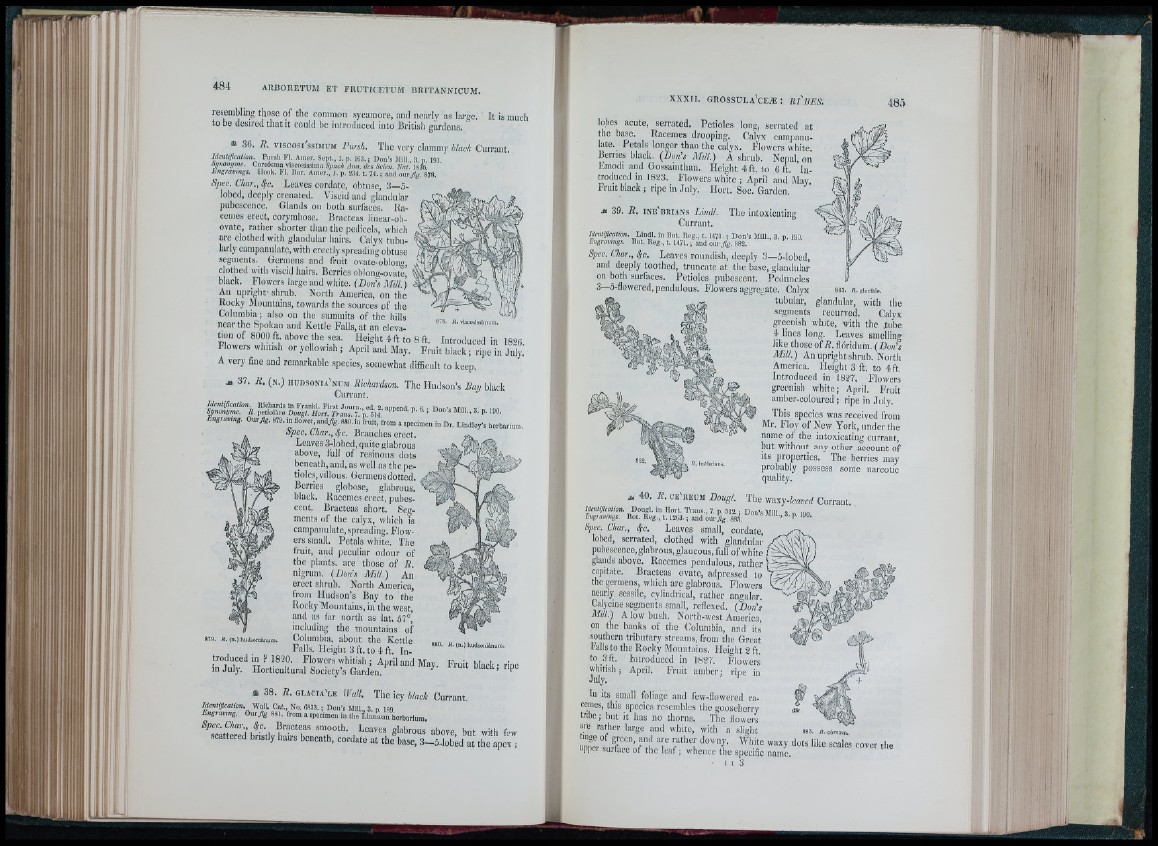
rescmljlbig those of the common sycamore, and nearly as largo. It is much
to he desu-cd that it could be introduced into Britisli gardens.
at 36. R. viscosi'ssiMUM Pursh. The very clainmy blade Currant.
Mentiflcation. Piirsl, Fl. Aracr. Sept., 1. p. 163. ; Don'» Mill., 3. p. 191
.Synonyme. Coreösma viscoBlssima flpacii Ann. des .Seien. Nat. Ifijß
tngramngs. Uook. Fl. llor. Amor., I. p. 2.34. t. 74. i .inil our Jig. 878.
Spec. Char., 4c. Leaves cordate, obtuse, 3—5-
lohed, deeply crenated. Viscid and glaiiilular
pube.scence. (Jlands on liotli surfaces. Ua-
ccmes erect, corymbose. Bracteas liiiear-ob-
ovate, rather shorter than the pedicels, wliich
are clothed with glandular hairs. Calyx tubularly
878. ft. vUcosîsslm
campanulate, with erectly spreading obtuse
segments. Germens and fruit ovate-oblong,
clothed with viscid hairs. Berries oblong-ovate,
black. Flowers large and white. (Doris Mill. )
An upright- sliriili. North America, on tlie
Rocky Mountains, towards the sources of the
Columbia ; also on the .summits of the hills
near the S|)okan and Kettle Falls, at an elevation
of 80ÜÜ ft above the sea. Height 4 ft to 8 ft. Introduced in 1826
Flowers whitish or yellowish ; April and May. Fruit black ; rijic in July.
A very fine and remarkable species, somewhat difficult to keep.
A. 37. R. (n .) hudsonia'nl-31 Richardson. The Hudson’s Ray black
Currant.
Identification. Richards in Frankl. First Journ., ed. 2. anoend n ß • Arm >.
Synonyme. Ji. petioliire Dougl. Hort. Trans. 7. p 514 ® Mill., .3. p. J90.
Lngramng. Ourßg. 879. in flower, undßg. sm. In iruit, from n .pcclmon in Dr. Linflloy’, hortarium.
Spec. Char., S/c. Branches erect.
Leaves 3-lobed, quite glabrous
above, full of resinous dots
beneath, and, as well as the pe-
tiole,s, villous. Germens dotted.
Berries globose, glabrous,
black. Racemes erect, puhes-
ccnt. Bracteas short. Segments
of the calyx, which is
campanulate,spreading. Flowers
small. Fetals wliite. The
fruit, and peculiar otioiir of
the plants, are tliose of K.
nigrum. (Doris Mill.) An
erect shi uh. North America,
from lIiid.8on’s Bay to the
Rocky Mountains, in the west,
and as far north as lat. 57°,
including the mountains of
Columbia, about tlie Kettle
Falls. Height 3 ft. to 4 ft. Introduced
m ’f 18-20. Flowers whitish ; April and May Fruit bhck- i-iiie
879. fl. (tl.)
in July. Horticultural Society’s Garden. ‘ u t black, iipe
* 38. R. GLACIA'LE WaU. The icy black Currant.
Identification. Wa lt Cat., No. 68.13. ; Don's Mill., 3 n 189
Engramng. O urßg 881. from a spccimon In tho ¿ I n n f t n horbarlum.
f t. (n.) hudsoniànum.
lobes acute, serrated. Petioles long, serrated at
the base. Raccines drooping. Calyx caiii|iaini-
late. Petals longer than the calyx. Flowers white
Berries black. (Doris Mill.) A shrub. Nepal, on
Emodi and GoHBaiiithan. Height 4 ft. to 6 ft. Introduced
in 1823. Flowers white ; April and May
Fruit black j ripe in July. Hort. Soc. Garden.
I 39. Ii. i n e ' b r i a n s Lindl.
Currant.
Thle intoxicating
Identification. Lindl. in Bot. Reg., t. 1471.; Don’s Mill., 3. p. 199.
hngravmgs. Bot. Reg., t. 1471.; and our 882.
Spec. Char., 4c. Leaves roundish, deeply 3 -5 -lo b ed ,
and deeply toothed, ti’uncate at the base, glaiuluUir
on both surfaces. Petioles pubescent. Peduncles
.... ou.inces.1 uLioies puiiesceni;,i'euuiicles
3—5-flowered, pendulous. Flowers aggregate. Calyx
— tubular,
J . 41 /-vl.rot'Awt T?I J'. 1
881. R. RlnOUe.
glandular, with the
segments recurved. Calyx
greenish white, with the tube
4 lines long. Leaves smelling
like those of R. fidridiim. (Doris
Mill.) An u)iright shrub. North
America. Height 3 ft. to 4 ft.
Introduced in 1827. Flowers
greenisli white; April. Fi-uit
amber-coloured ; ripe in July.
This species was received from
Mr. Floy of New York, under the
name of the intoxicating currant,
but without any other account of
its properties. The lierrios may
probably possess some narcotic
quality.
A. 40. R. C E'R EU.1 Dougl. The waxy-fcaac« Currant.
lieniHkailon. Dougl. in Hort. Tnin»., 7. p. .312. j Don’s Mill 3 i, 190
Engravmgs. Bot. Ueg., t. l'2C3. i and o u rjig . 8Sii. ’ ' '
Spec. Char., f r . Leaves small, cordate,
lobed, serrated, clothed with glandular
pubescence,gliihroiis, glaucous, full of white ,1
glands above. Racemes pendulous, rather
capitate. Bracteas ovate, adpressed to
the germens, which are glabrous. Flowers
nearly sessile, cylindrical, rather angular,
ftlycine segments small, reflexed. (Doris
Mill.) A low bush. North-west America,
on the hanks of the Columbia, and its’
southern trilmtary streams, from the Great
Palls to the Rocky Mountains. Iieight 2 ft.
to 3ft. I'ntrodiiccd in 1827. Flowers
whitish; April. Fruit amber; ripe in
July.
In Its small foliage and few-flowered racemes,
this species resembles the gooseberi-y
tribe ; but it has no thorns. The flowers
are raffici- large and white, with a slight »8.1. « . cW sm .
Z f a r i Z n T T ‘'" " T “k® reales cover the uppei SQitacc of the leaf ; whence the specific name.
- I I 3
I I